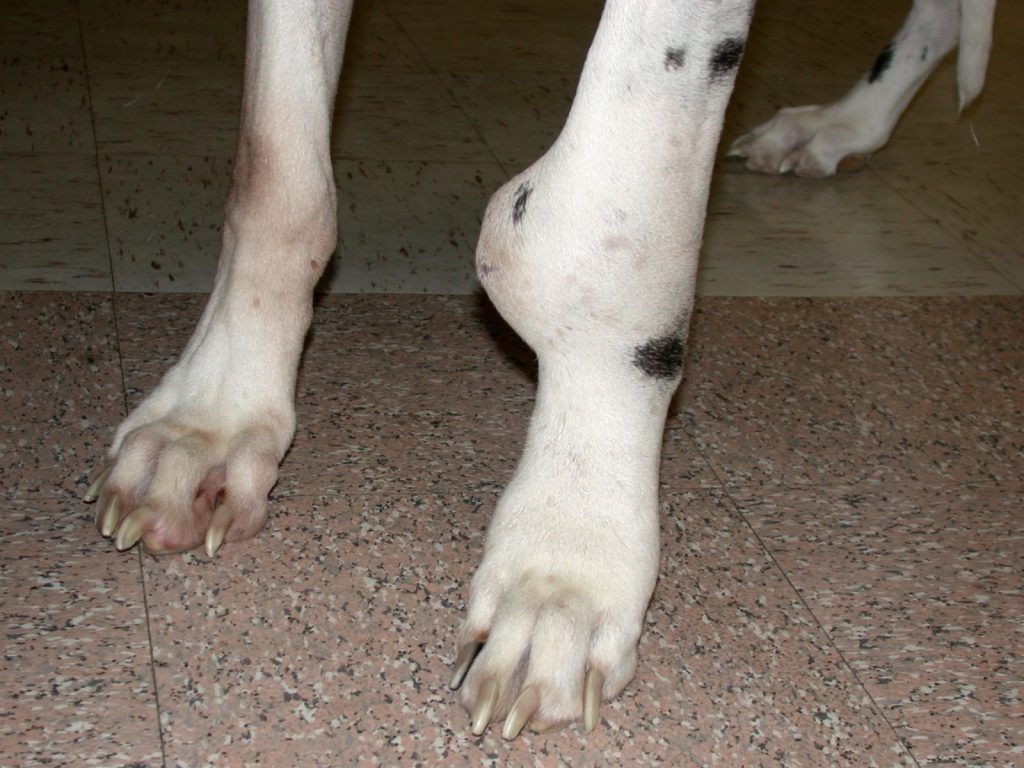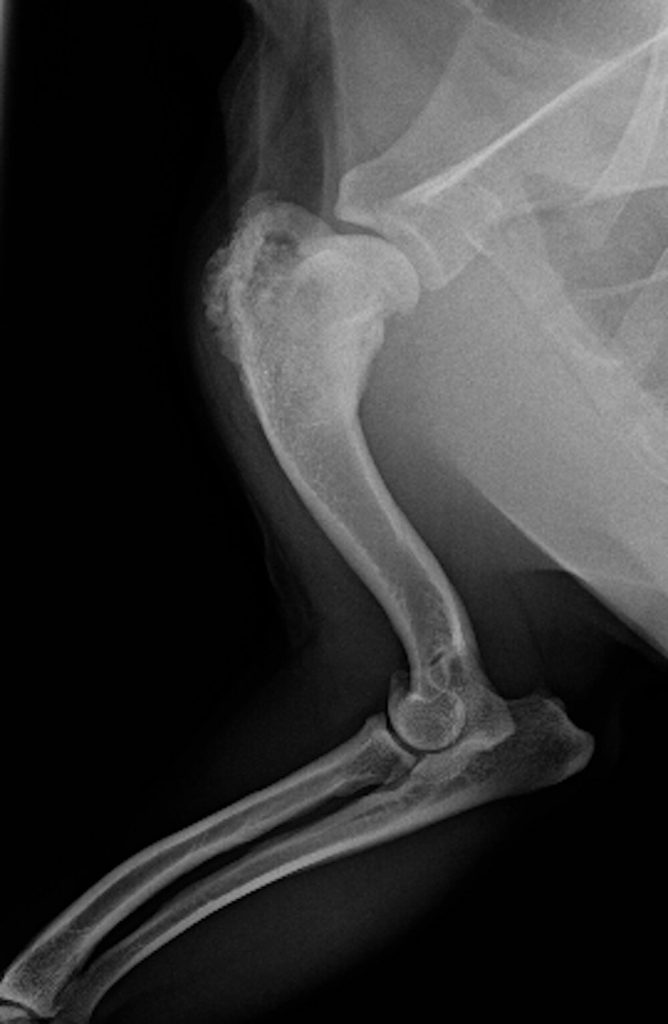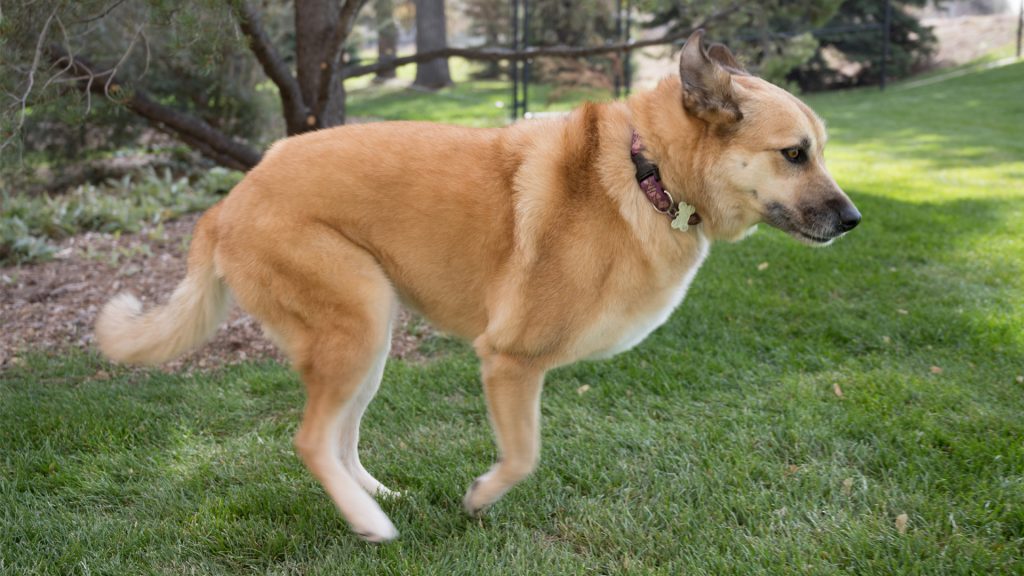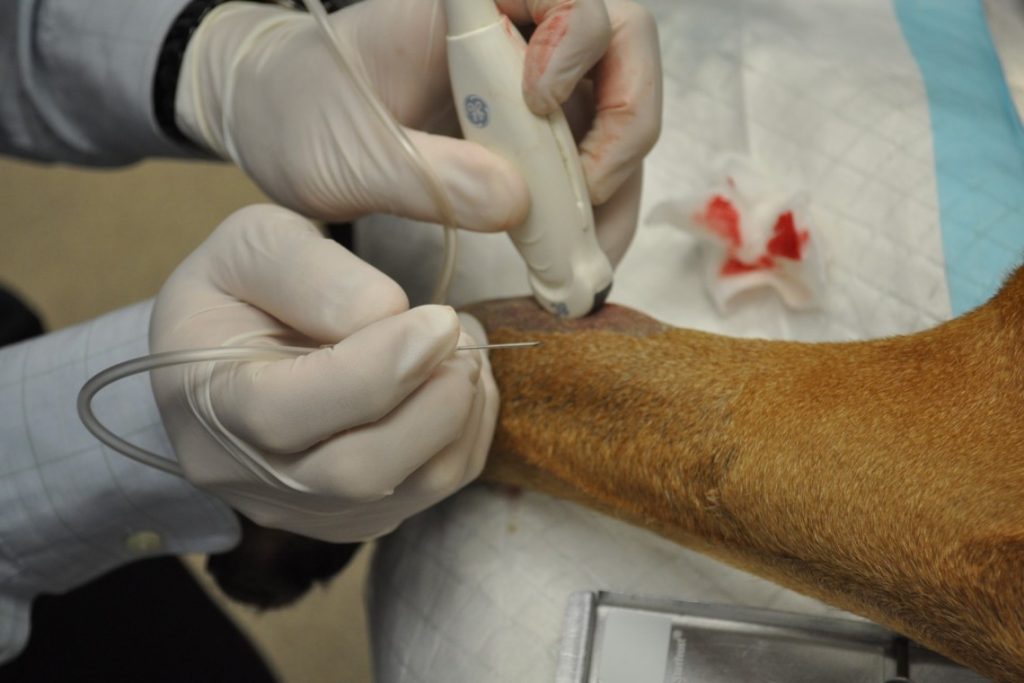Osteosarcoma is the most common bone tumor in dogs, constituting 85% of malignant tumors. Presents itself most often in the bones of the extremities of the dog, although it can also develop in the bones of the skull, the spine or the rib cage.
In some casesalthough rare, this tumor arises in non-osseous tissuessuch as mammary glands and muscles.
Although there is no specific cause, it is believed to be related to genes
that promote and suppress the growth of tumor cells.
What is osteosarcoma and how does it occur?
Osteosarcoma is a malignant bone tumor that arises from the abnormal production of cells that make and break down bone (called osteoblasts and osteoclastsrespectively).
usually affect the long bones (arms and legs), although tacan also affect to bones like jaw, hips, or pelvis.
Sdevelops deep in the bone and it progresses outwards, becoming progressively more painful. The bone is destroyed from the inside out and the dog begins to exhibit intermittent lameness, which becomes constant over time. TO as the tumor grows, the swelling becomes apparent.
He tumor bone is not as strong as normal bone and can break with a small injury. This type of fracture is called pathological fracture and it may be the finding that confirms the diagnosis of bone tumor. Pathologic fractures do not heal and there is no point in casting or attempting surgical stabilization.
Osteosarcoma also can affect non-osseous tissuessuch as the mammary glands, spleen, liver and kidneys. In this case it is called extraskeletal osteosarcoma.

Osteosarcoma in Dogs: Detection, Prevention, and Treatment
Does osteosarcoma occur in all dogs equally?
Although any dog can develop osteosarcoma, it is more common in big or giant dog breeds. Apparently, its development is related to the weight and height of the dog.
Las most affected breeds son:
- Boxer
- Doberman
Pinscher - greyhound
- Golden
Retriever - great dane
- great pyrenees
- Labrador
Retriever - Irish Wolfhound
- German shepherd
- Rottweiler
- Saint Bernard
- Irish Setter
- Weimaraner

Is canine osteosarcoma painful for my dog? What are your symptoms?
Osteosarcoma of the bones of the extremities can be extremely painful and usually manifests itself through an intermittent limpwhich does not improve with rest or responds to pain relievers.
The lameness may initially respond to standard doses of analgesics, but rarely lasts more than a week. At that moment you can see a inflammation of the bone at the tumor site, which is often painful, red, and hot to the touch.
In addition, it is possible that the dog appear lethargic, with loss of appetite, tremors or chills, behavior changes, and reduced physical activity.
It should also be taken into account that canine osteosarcoma spreads rapidly through the bloodstream. Therefore, any treatment plan must address the primary tumor, but also its secondary spread.
Las most common areas of osteosarcomas in dogs are the radius and ulna (ulna), above front knee) and the tibia/fibula (below the rear knee), but osteosarcomas also occur in the toes, femur (above the rear knee), and hip.
Sometimes, due to the changes that the cancer causes in the bone architecture, the bone becomes weak and ends up fracturing, which is also known as pathological fracture.
He osteosarcoma in the mouth It can present as bad breath. You may also see blood in the food or water bowl or a visible mass near the teeth or gums.
If he
osteosarcoma is in the bones of the skullthe tumor can cause changes in its appearance and facial symmetry, or grow into the brain cavity, which can cause seizures.
He spinal osteosarcoma it can compress the spinal cord or nerves, making it difficult for your dog to walk, partially or even completely.
He osteosarcoma
costal it may appear as a firm, fixed swelling under the skin of the rib cage, often about 2/3 of the length of the rib.
How is canine osteosarcoma diagnosed?

Osteosarcoma in Dogs
- Most dogs with osteosarcoma have a lameness of one limb. The swelling
It is usually felt where the tumor has grown, and the area will be hot to the touch due to enormous swelling. - The vet will x-rays of the affected area. Osteosarcomas have a lytic (ie, pieces of bone are missing) or “moth-eaten” appearance due to loss of normal bone tissue. There may be fractures if the bone has become weak enough.
- Although osteosarcoma in dogs cannot be definitively diagnosed from x-rays alone, they do allow for a presumptive diagnosis and in many cases it is not necessary biopsy.
- In addition, x-rays of the lungs are obtained to rule out the presence of detectable lung cancers.
- Any other painful bone lesions should be investigated and, if there is enlarged lymph nodes in the region of the primary tumor, these should be evaluated by a fine needle aspiration biopsy.
- Fine needle aspiration allows for a more accurate diagnosis. is done under sedation and consists of taking a sample of cells directly from the lesion. When this procedure is not diagnostic, a bone biopsy is warranted.
- In most cases, lytic bone lesions found on radiographs are indicative of an infectious or malignant process, so other diagnoses are always recommended.
- As the micrometastasis is frequent, in dogs with osteosarcoma the staging (search for possible spread to other parts of the body).
- This may include blood testurinalysis, x-rays of the lungs, and possibly an abdominal ultrasound.
- If the lymph nodes enlarge or are abnormal, more samples may be taken to determine if there is spread.
Osteosarcoma Treatment in Dogs
The first goal of treatment for osteosarcoma is bone pain relief and the restoration of a good quality of life. The second objective is the longevity. Chemotherapy has been shown to prolong the life of dogs suffering from this disease.
Treatment of the primary tumor
The ideal treatment consists of complete removal of the primary tumor
and this implies amputation. Many dogs do remarkably well after amputation, but this is not appropriate for all dogs. Concurrent neurological problems or severe arthritis are reasons not to consider amputation.
Moderate arthritis can be managed very well with a proper medication and it doesn’t have to be a reason not to consider amputation. Amputation makes the pain go away and the dog usually recovers fairly quickly.
In case amputation is considered inappropriate, there are Other options.
In the case of distal radius osteosarcomas (i.e. the lower forelimb, just above the equivalent of the wrist joint in dogs) an operation may be performed in which the tumor is removed and replaced with a implant custom titanium The wrist joint has to be fused, so that all the bony and metal construction can be properly stabilized and the dog can go back to its normal daily routines without being affected.
He The objective of this procedure is to restore the dog’s mobility normal in the shortest possible time. It is essential to stress that the degree of tumor control offered by this option may be, at best, equivalent to amputation.
There is also the risk of the tumor coming back in the limb at the site of the primary tumor at some point in the future. Also, this procedure is associated with a high risk of complicationsthe worst of which is infection associated with metallic implants.
For dogs where amputation and so-called limb-sparing surgery are not suitableyou can administer a palliative therapy en form of radiation therapy and chemotherapy. The standard palliative therapy protocol involves the co-administration of radiation therapy in three of four consecutive weeks with chemotherapy along with the first and last doses.

Treatment of secondary spread
Unfortunately, the development of a metastatic secondary cancer is what leads to euthanasia in many osteosarcoma patients. Optimal results are achieved by treating both the primary and secondary tumor. The best setting for treating secondary cancer is when there are no signs of spread on x-rays and other initial diagnostic tests. The treatment used is chemotherapy.
In recent years, veterinary oncologists have tried new combinations of chemotherapeutic agents for the treatment of secondary cancer of osteosarcoma in dogs. Despite increasing levels of side effects, there remains no evidence of improved outcomes associated with these treatment protocols. In most cases, chemotherapy treatment is uneventful.
What is the prognosis for canine osteosarcoma?
- Osteosarcoma in dogs is extremely aggressive. At the time of diagnosis, about 90-95% of dogs will have micrometastases, which means that the cancer cells have already spread to other places even though they are not detectable. The metastasis usually extends to the lungs.
- no therapy the average time of survival is about two months. This is mainly determined by the discomfort associated with the primary tumor.
- And it is realized at amputation the median survival time increases to six months and a half, with 2% of patients alive after two years.
- The patients who receive radiotherapy and chemotherapy palliative care have an average life expectancy of six months.
- The amputation with chemotherapy makes the average time of Survival is less than one year with 20% of dogs continuing to enjoy a good quality of life two years after surgery.
- Los dogs undergoing limb-sparing surgery and chemotherapy they experience the same survival time as those who undergo amputation and chemotherapy.
- Not all of the treatment options described are suitable for all dogs. Although it is important that owners are aware of the options and the reasons for choosing one treatment over another, the The final decision on which treatment plan is most appropriate will be made by the veterinary oncologist.

conclusions
- Osteosarcoma is a genetic bone tumor
- It usually occurs in the extremities, although it can appear in other bones and in non-bone areas.
- Although it can appear in any dog, it occurs more frequently in large and giant breeds.
- It is extremely painful and the main symptom is an intermittent limp that becomes permanent.
- It is easy for metastasis to occur
- The diagnosis is made by radiography. In some cases, it is advisable to perform a biopsy under sedation.
- As micro metastasis is frequent, it is recommended to detect its possible spread.
- Pay attention to changes in the size of the lymph nodes
- Amputation is used to remove the primary tumor.
- Secondary spread is treated with chemotherapy
- The treatment increases the dog’s life span and allows it to be free from pain. However, it is difficult for him to survive more than 2 years.
- If you think your dog may have osteosarcoma, go quickly to the vet.



